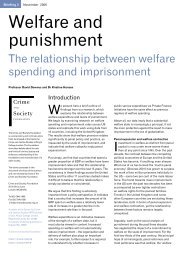PRISON SERVICE
PRISON SERVICE
PRISON SERVICE
- No tags were found...
You also want an ePaper? Increase the reach of your titles
YUMPU automatically turns print PDFs into web optimized ePapers that Google loves.
increase and decrease the likelihood of offendingbehaviour.Therapeutic Milieu Treatment within the unitaims at creating the quality of interpersonalrelationships and remedial experiences that are believednecessary for people to attain the capacity to developsocially adaptive cognitive, emotional and behaviouralresponses. The aim is for all staff to develop appropriaterelationships with prisoners through which they canexperience reparative interventions that will change allaspects of their functioning. All staff engage withprisoners in this way and Schema-Focused TreatmentPlans are in situ for all prisoners in order to guide allstaff in their interactions with prisoners. Thus,interactions with staff upon the landing are consideredas necessary for change as the more formalpsychological interventions and prisoners are able toaccess a high level of support via access to operationalstaff. Attention is also given to the prisoner’semployment to ensure that their job is not maintainingtheir psychopathology. For instance, obsessivecompulsive prisoners are not provided withemployment as cleaners since this prevents them fromacquiring new ways to manage the emotions that theyavoid by cleaning.OutcomesAttendance at Therapy SessionsPeople with a diagnosis of personality disorder arenotoriously difficult to engage in therapy, particularly in anemotionally meaningful way. This is one of thecharacteristics that gave them the oft quoted label thatthey were ‘untreatable’. The prisoners who completedtreatment however were highly engaged in therapy andtheir attendance far exceeded what would be predictedfor this complex and damaged client group (Chart 6).Indeed many men had an attendance rate of over 95 percent in all interventions. These are not accreditedprogrammes, and there is an expectation but nocompulsion to attend the sessions. As is characteristic ofthis client group, some of the men withdrew for periods ofvarying length and then re-engaged. Such ruptures intherapy are predictable for this client group, and for mostmen necessary to establish genuine change. Part of thehigh attendance rate is attributable to the slow build-up ofthe therapeutic interventions. Experience indicates thattherapeutic engagement is facilitated by the establishmentof an appropriate individual therapeutic relationship andthe gradual introduction of therapeutic interventions to amaximum of five formal therapy sessions.Overview of Fens Unit Cognitive Interpersonal Treatment Programme0 - 6 6 - 12 12 - 18 18 - 24 24 - 30 30 - 36 36 - 42 42 - 48 48 - 54 54 - 60Months months months months months months months months months monthsINDIVIDUALTHERAPYINDIVIDUAL THERAPY(focuses on the developmental roots of the personality disorder)PDAwareness(0 - 3months)HumanRelationships(4 — 6months)GROUPWORKCOGNITIVE INTERPERSONAL GROUP THERAPY(addresses dysfunctional relationships)SCHEMA FOCUSED THERAPY GROUP(addresses thinking errors)AFFECT REGULATION GROUP(addresses emotionaldysregulation)OFFENCE FOCUSED THERAPY(summarises workon offending)ADDICTIVEBEHAVIOURS GROUPHEALTHY SEXUALRELATIONSHIPS50 Prison Service JournalIssue 192











